NCERT Solutions For Class 11 Biology Morphology of Flowering Plants
Topics and Subtopics in NCERT Solutions for Class 11 Biology Chapter 5 Morphology of Flowering Plants:
| Section Name | Topic Name |
| 5 | Morphology of Flowering Plants |
| 5.1 | The Root |
| 5.2 | The Stem |
| 5.3 | The Leaf |
| 5.4 | The Inflorescence |
| 5.5 | The Flower |
| 5.6 | The Fruit |
| 5.7 | The Seed |
| 5.8 | Semi-technical Description of a Typical Flowering Plant |
| 5.9 | Description of Some Important Families |
| 5.10 | Summary |
NCRT TEXTBOOK QUESTIONS SOLVED
1.What is meant by modification of root? What type of modification of root is found in the:
(a) Banyan tree
(b) Turnip
(c) Mangrove trees
Soln.Roots of some plants change their shape and structure and become modified to perform certain functions other than absorption and conduction of water and minerals. It is called modification of roots. Roots are modified for support, storage of food and respiration, etc.
(a) Root modification in banyan tree : In banyan tree, the root modifies to form prop roots. Prop roots arise from branches and enter the soil. Thus, they provide mechanical support to densely branched, huge trees.
(b) Root modification in turnip : The
modification of root found in turnip is napiform for food storage. The upper portion of these fleshy roots is inflated or swollen which tapers towards the lower end.
(c) Root modification in mangrove trees : In mangrove plants, i.e., plants growing in saline marshes, the branches of tap root come out of the ground and grow vertically upwards showing negative geotropism. These roots are called pneumatophores. They help to get oxygen for respiration.
2.Justify the following statements on the basis of external features:
(i) Underground parts of a plant are not always roots.
(ii) Flower is a modified shoot.
Soln. (i) Underground parts of plant are not always roots because sometimes the stem also becomes underground and gets modified into various forms to perform different functions of storage, vegetative propagation, perennation, etc. Underground modifications of stems are tuber, rhizome, corm and bulb. The underground stems can be distinguished from roots externally by the presence of nodes and internodes, axillary buds, scale leaves etc. and by absence of root cap and root hairs.
(ii) Flower is the reproductive part of the angiospermic plant and it is defined as the modified shoot because (a) like shoot, flower develops from an axillary or rarely terminal bud. (b) flowers may get modified into fleshy buds or bulbils, (c) A transition from foliage leaves to floral leaves is found in Paeonia. (d) Nymphaea shows transition from sepals to petals and petals to stamens, (e) In Passiflora and Cleome long intemodes occur below gynoecium and stamens.
3.How is a pinnately compound leaf different from a palmately compound leaf?
Soln.The compound leaves may be of two types, pinnately compound leaf and palmately compound leaf. In pinnately compound leaf, a number of leaflets are present on a common axis, the rachis, which represents the midrib of the leaf as in neem. Pinnately compound leaf may be of different types as unipinnate, bipinna te, tripinna te and decompound. In palmately compound leaf, the leaflets are attached at a common point, i.e., at the tip of petiole, as in silk cotton. Palmately compound leaf may be of different types as unifoliate, bifoliate, trifoliate, quadrifoliate and multifoliate.
4.Explain with suitable examples the different types of phyllotaxy.
Soln.Phyllotaxy is the pattern of arrangement of leaves on the stem or branch. It is usually of three types – alternate, opposite and whorled. In alternate type of phyllotaxy, a single leaf arises at each node in alternate manner, as in china rose, mustard and sunflower plants. In opposite type, a pair of leaves arises at each node and lie opposite to each other as in Calotropis and guava plants.
If more than two leaves arise at a node and form a whorl it is called whorled phyllotaxy as in Alstonia.
5.Define the following terms:
(a) aestivation (b) placentation
(c) actinomorphic (d) zygomorphic
(e) superior ovary (f) perigynous flower (g) epipetalous stamen.
Soln. (a) Aestivation : The mode of arrange¬ment of accessory floral organs (sepals and petals) in relation to one another in floral bud is known as aestivation. The main type of aestivation are valvate, twisted, imbricate, and vexillary.
(b) Placentation : The arrangement of ovules within the ovary is known as placentation. The placentation are of different types namely, marginal, axile, parietal, basal, and free central.
(c) Actinomorphic : When flower can be divided into equal radial halves in any radial plane passing through the centre, it is said to be actinomorphic, e.g., mustard, Datura etc.
(d) Zygomorphic : When a flower can be divided into two similar halves only in one particular vertical plane, it is said to be zygomorphic, e.g., pea, gulmohar, bean, Cassia.
(e) Superior ovary : In hypogynous flower, the gynoecium occupies the highest position while the other parts are situated below it. The ovary in such flowers is said to be superior, e.g., mustard, brinjal.
(f) Perigynous flower: If gynoecium is situated in the centre and other parts of the flower are
located on the rim of the thalamus almost at the same level, it is called perigynous. Here ovary is half superior, e.g., peach, plum.
(g) Epipetalous stamen : When stamens are attached to the petals, they are called epipetalous stamens e.g., brinjal.
6.Differentiate between
(a) Racemose and cymose inflorescence
(b) Fibrous root and adventitious root
(c) Apocarpous and syncarpous ovary
Soln.
(a) Differences between racemose and cymose inflorescence are as follows: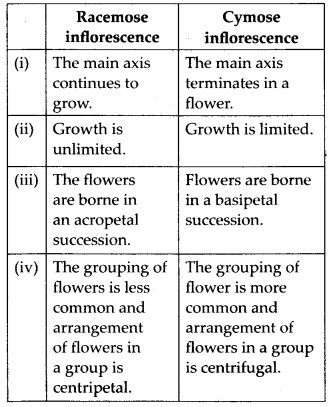
(b) Differences between fibrous and adventitious roots are as follows :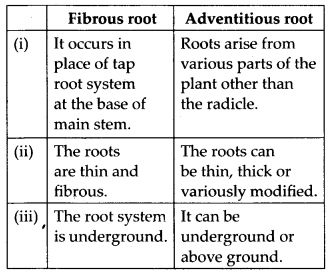
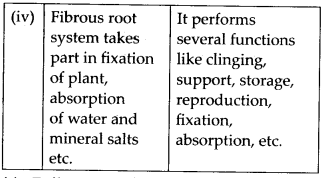
(c) Differences between apocarpous and syncarpous ovary are as follows :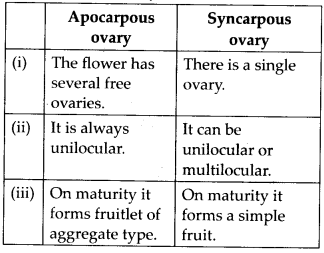
7.Draw the labelled diagram of the following:
(i) Gram seed (ii) V. S. of maize seed.
Soln.
(i) Gram seed.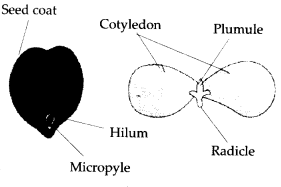
(ii) V.S. of maize seed.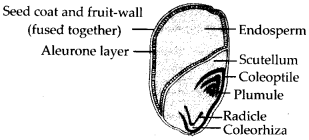
8.Describe modifications of stem with suitable examples.
Soln. Stems are modified to perform different functions. Underground stems of some plants are modified to store food in them. They also act as organs of perennation to tide over conditions unfavourable for growth. Different modifications of stem are :
(i) Underground modifications
(ii)Sub-aerial modifications
(iii)Aerial modifications
(i)Underground modifications of stem are discussed as follows:
(a)Tuber: It is the branch of main stem which accumulates or stores food in it and swells up, e.g., Solarium tuberosum (potato).
(b) Rhizome: It is a branched, prostrate horizontally growing stem having nodes and internodes. On the nodes sessile scale leaves are formed, e.g., Carina, Zingiber officinale (ginger), Curcuma domestica (turmeric) etc.
(c) Corm: This is a spherical,
branched, vertically growing thick underground stem with more diameter than length, e.g., Crocus sativus (saffron), Gladiolus, Colocasia esculenta (arvi) etc.
(d) Bulb: In bulb the stem is highly reduced and can be seen only as a disc-like structure bearing numerous fleshy scaly leaves, e.g., Allium cepa (onion), Allium sativum (garlic) etc.
(ii) Subaerial modifications : Subaerial part of stem grows horizontally on the ground while some part remains underground. Vegetative propagation takes place by means of these. They may be of following kinds.
(a) Runner: It grows prostrate on the surface of soil. It develops at the base of erect shoot called crown. A number of runners arise from one erect shoot which spread in different directions. Each runner has one or more nodes which bear scale leaves and axillary buds, e.g., Cynodon (doob grass).
(b) Stolon: The nodes of horizontally growing underground stem give rise to branches which come out of the soil, e.g., Fragaria (strawberry).
(c) Sucker: Suckers are formed from the node of underground stem. Sucker comes up obliquely in the form of leafy shoot, e.g., Mentha (mint).
(d) Offset: Stem consists of thick and short intemodes. The branches are formed from the main stem and upper portion of each branch bears a group of leaves while the lower portion bears the roots. Each branch is capable of growing as an independent plant after separating from the parent plant, e.g., Eichhornia (water hyacinth), Pistia, etc.
(iii)Aerial modifications : The aerial portion of stem is modified to perform different functions, e.g., climbing, protection, food manufacturing, etc. It may show following types of modifications:
(a) Twinners : The stem is long, flexible and sensitive which can coil around an upright support like a rope, e.g., Ipomoea, Convolvulus.
(b) Climbers : The stem is weak and flexible but is unable to coil around an upright support by itself. It requires the help of clasping or clinging structures. Accordingly, climbers are of four types : root climbers, e.g., Betel; tendril climber, e.g., Passiflora; scramblers, e.g., Bougainvillea and lianas, e.g., Bauhinia.
(c) Phylloclade: The stem performs the function of photosynthesis. The stem modifies into green fleshy leaf-like
structure having distinct nodes and intemodes. Leaves of such plants are reduced into spines in order to prevent loss of water, e.g., Opantia (prickly pear), Euphorbia.
(d) Cladode: It is similar to phylloclade with only one internode, e.g., Asparagus.
(e) Thorn: Stem is modified into stiff, pointed unbranched or branched structures which have lost their growing point and become hard, called as thorns, e.g., Bougainvillea,Pomegranate, Citrus, etc. They perform defensive function.
(f) Tendrils : These are thread like sensitive structures which can coil around a support and help the plant
in climbing, e.g., Cucurbita.
(g) Bulbils: In some plants vegetative buds or floral buds modify into a swollen structure called bulbil. It separates from the parent plant and on approach of favourable condition gives rise to a new plant, i.e., it is an organ of vegetative reproduction, e.g., Agave, Oxalis.
9.Take one flower each of the families Fabaceae and Solanaceae and write their semi-technical description. Also draw their floral diagram after studying them.
Soln.Family Fabaceae (e.g., Pisum sativum) Systematic position:
Class – Dicotyledoneae
Subclass- Polypetalae
Series – Calyciflorae
Order – Rosales
Family – Fabaceae
Vegetative characters:
Habit: herb. Root: tap, branched, with root nodules.
Stem: herbaceous, climbing.
Leaves : pinnately compound, leaf base pulvinate, stipulate, venation reticulate.
Floral characters:
Inflorescence: racemose.
Flower : bisexual, zygomorphic, irregular, hermaphrodite, white or pink, complete, hypogynous to perigynous.
Calyx : sepals five, gamosepalous, ascending, imbricate aestivation, campanulate calyx tube.
Corolla : petals five, polypetalous, vexillary aestivation, papilionaceous, consisting of a posterior standard or vexillum two lateral wings or alae, two anterior ones forming a keel.
Androecium : 10 stamens in two bundles (diadelphous) of (9) + 1, anthers dithecous (bilobed), basifixed, introrse.
Gynoecium : ovary superior, monocarpellary, unilocular with many ovules, marginal placentation, style bent and long, stigma simple and-hairy.
Fruit : legume; seeds one to many, non- endospermic.
Floral formula : ![]()
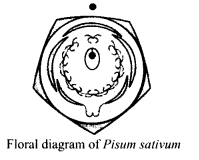
Family Solanaceae (e.g., Solanum nigrum) Systematic position:
Class Subclass Series Order Family
Vegetative characters:
Habit: herbs Stem : herbaceous, aerial, erect, cylindrical, branched.
Leaves: alternate, simple, exstipulate, venation reticulate.
Floral characters:
Inflorescence: cymose.
Flower : ebracteate, ebracteolate, bisexual, actinomorphic, white, hypogynous.
Calyx : sepals five, gamosepalous, persistent, valvate aestivation.
Corolla : petals five, gamopetalous, valvate. aestivation.
Androecium : stamens five, epipetalous, polyandrous, anthers large, bithecous and basifixed.
Gynoecium : bicarpellary, syncarpous,
ovary, obliquely placed carpels in the flower, bilocular, axile placentation, placenta swollen with many ovules.
Fruits : berry with persistent calyx.
Floral formula :![]()
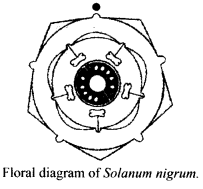
10.Describe the various types of placentations found in flowering plants.
Soln.Placenta is a parenchymatous cushion present inside the ovary where ovules are borne. The number, position, arrangement or distribution of placentae inside an ovary is called placentation. The placentation are of different types namely, marginal, axile, parietal, basal and free central.
(i)Marginal placentation : The placenta forms a ridge along the ventral suture of the ovary and the ovules are borne on this ridge forming two rows, e.g., pea.
(ii)Axile placentation : When the placenta is axial and the ovules are attached to it in a multilocular ovary, the placentation is said to be axile, e.g., china rose, tomato and lemon.
(iii)Parietal placentation : The ovules develop on the inner wall of the ovary or on peripheral part. Ovary is one-chambered but it becomes two-chambered due to the formation of the false septum, e.g., mustard and Argemone.
(iv)Free central placentation : When the ovules are borne on central axis and septa are absent, as in Dianthus and primrose the placentation is called free central.
(v)Basal placentation: The placenta develops at the base of ovary and a single ovule is attached to it, as in sunflower, marigold.
11.What is a flower? Describe the parts of a typical angiosperm flower.
Soln.Flower is the reproductive unit in the angiosperms. It is meant for sexual reproduction. A typical flower has four different kinds of whorls arranged successively on the swollen end of the stalk or pedicel, called thalamus or receptacle. These are calyx, corolla, androecium and gynoecium.
Calyx and corolla are accessory organs, while androecium and gynoecium are reproductive organs. In some flowers like lily, the calyx and corolla are not distinct and are termed as perianth. Some flowers have both androecium and gynoecium and are termed hermaphrodite flowers while some flowers have only one of these two whorls.
Calyx : The calyx is the outermost whorl of the flower and its units are called sepals. Generally, sepals are green, leaf like and protect the flower in the bud stage. The calyx may be gamosepalous (sepals united) or polysepalous (sepals free).
Corolla : Corolla is composed of petals. Petals • are usually brightly coloured to attract insects for pollination. Like calyx, corolla may also be free (polypetalous) or united (gamopetalous). The shape and colour of corolla vary greatly in plants. Corolla may be tubular, bell-shaped, funnel-shaped or wheel-shaped.
Androecium : Androecium is the male reproductive part of the flower. It is composed of stamens. Each stamen which represents the male reproductive organ consists of a stalk or a filament and an anther. Each anther is usually bilobed and each lobe has two chambers, the pollen-sacs. The pollen grains are produced in pollen-sacs. A sterile stamen is called staminode.
Gynoecium : Gynoecium is the female reproductive part of the flower and is made up of one or more carpels. A carpel consists of three parts namely stigma, style and ovary. Ovary is the enlarged basal part, on which lies the elongated tube, the style. The style connects the ovary to the stigma. The stigma is usually at the tip of the style and is’ the receptive surface for pollen grains. Each ovary bears one or more ovules attached to a flattened, cushion-like placenta. When more than one carpel is present, they may be free (as in lotus and rose) and are called apocarpous. They are termed syncarpous when carpels are fused, as in mustard and tomato. After fertilisation, the ovules develop into seeds and the ovary matures into a fruit.
12. How do the various leaf modifications help plants?
Soln.Leaves perform various functions besides photosynthesis and thus they are modified into different forms such as –
(i)Leaf tendrils: The different parts of a leaf are modified into tendrils which help the plant in climbing up. Parts of leaf modified into tendrils include stipules e.g., Smiiax ; petiole e.g., Clematis ; leaf apex e.g., Gloriosa ; leaflets e.g., Pisum; whole leaf e.g., Lathyrus.
(ii)Leaf spines: Either for the protection of plant or to lessen the rate of transpiration in xerophytic plants, the leaves modify into sharp, pointed spines. Parts of leaf modified into leaf spines include stipules e.g., Zizyphus; leaf margins e.g., Argemone; leaf apex e.g.r Yucca; entire leaf e.g., Berberis.
(iii)Phyllode: Petioles modify into leaf¬like green, photosynthesising structure e.g., Parkinsonia, Acacia auriculiformis.
(iv)Scale or protective leaves : The leaves modify into hard scaly leaves which protect the vegetative bud by covering them, e.g., Ficus, Artocarpus, Casuarina, etc.
(v) Leaf hooks : They help in climbing e.g., Bignonia.
(vi)Leaf roots : A leaf transforms into roots for balancing on water e.g., Salvinia.
(vii)Leaf pitchers : Leaf is modified into pitcher e.g., Nepenthes (insectivorous), Dischidia (non-insectivorous).
(viii)Leaf bladder: The leaves modify to form bladder like structure which trap insects and then it is closed by a valve present on the mouth of bladder e.g., Utricularia (bladderwort).
(ix) Leaf tentacles: The leaf of sundew plant, Drosera bear minute hairs which have shinning, sticky substance at their tips (tentacles). When any insect sits on the leaf, it is covered by these hairs.
13. Define the term inflorescence. Explain the basis for the different types of inflorescence in flowering plants.
Soln. The arrangement of flowers on the floral axis is termed as inflorescence. A flower is a modified shoot wherein internodes do not elongate and the axis gets condensed. The apex produces different kinds of floral appendages laterally at successive nodes instead of leaves. When a shoot tip transforms into a flower, it is always solitary. Depending on whether the apex gets converted into a flower or continues to grow, two major types of inflorescence are defined – racemose and cymose. In racemose type of inflorescence the main axis continues to grow, the flowers are borne laterally in acropetal succession. In cymose type of inflorescence the main axis terminates in a flower, hence is limited in growth. The flowers are borne in a basipeta! order.
14. Write the floral formula of an actinomorphic, bisexual, hypogynous flower with five united sepals, five free petals, five free stamens and two united carples with superior ovary and axile placentation.
Soln. The floral formula for actinomorphic, bisexual, hypogynous flower with five united sepals, five free petals, five free stamens and two united carples with superior ovary and
axile placentation is:
15.Describe the arrangement of floral members in relation to their insertion on thalamus.
Soln. In a typical flower, the floral members like calyx, corolla, androecium and gynOecium are arranged over the thalamus! Based on the position of calyx, corolla and androecium in respect to ovary on thalamus, the flowers are described as hypogynous, perigynous and epigynous ones. In the hypogynous flower the gynoecium occupies the highest position while the other parts are situated below it. The ovary in such flowers is said to be superior, e.g., mustard, china rose and brinjal. If gynoecium is situated in the centre and other parts of the flower are located on the rim of the thalamus almost at the same level, it is called perigynous. The ovary here is said to be half inferior or sub superior, e.g., plum, rose, peach. In epigynous flowers, the margin of thalamus grows upward enclosing the ovary completely and gets fused with it; the other parts of flower arise above the ovary. Hence, the ovary is said to be inferior as in flowers of guava and cucumber, and the ray florets of sunflower.
Post a Comment